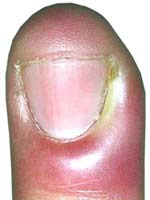What is paronychia
Paronychia is bacterial infections of the hand right next to a nail wherein the nail and skin layers connect, at the side or perhaps the base of a nail. The affected nail fold is inflamed, sore and could be sensitive. Clinically, paronychia can be acute or a chronic problem. Paronychia is a small, superficial bacterial infection or abscess of the paronychial area of the hands or maybe, unusually, the feet. Sometimes there is a little accumulation of pus in the abscess. The nail can be infected also, in case a nail fold infection is neglected.
Paronychia symptoms
The signs and symptoms of acute and chronic paronychia, are identical. Determined by the reason for the condition, paronychia could occur gradually and persist for weeks or perhaps occur unexpectedly and persist for just a day.
The signs and symptoms of paronychia are simple to identify and can be effectively treated with minimal deterioration of the skin and nails. If ignored, the problem can evolve into serious and lead to total loss of the nail. Both of those bacterial infections have the following signs and symptoms: inflammation of the epidermis around the nail, sensitivity of the epidermis around the nail, pus packed blisters, modifications in nail structure, shade, or surface, separation of the nail.
Acute paronychia
Acute paronychia is an unpleasant problem, commonly a result of Staphylococcus aureus, streptococci or direct damage to the cuticle or nail fold, and could be from very trivial situations, for example dishwashing, a wound from a splinter, nail biting, an ingrown nail, or manicure treatments.
Occasionally yellow pus shows up under the cuticle. Sometimes acute paronychia is followed by fever and swollen glands under the arms.
Acute paronychia generally clears entirely in a couple of days, and almost never recurs.
Chronic paronychia
Chronic paronychia is a slow process and far more hard to overcome. Chronic paronychia is generally a result of a fungal contamination. Chronic paronychia is a skin infection of the folds of tissue mass adjoining the nail, persisting five to six weeks.
Every impacted nail fold is inflamed and raised off the nail plate. It could be reddish and sensitive every once in awhile, and occasionally a bit of pus could be displayed from under the cuticle. Chronic paronychia is a nail condition common in people whose fingers are affected by wet local surroundings, and sometimes because of exposure to the dermatitis. The nail plate is likely to become twisted out of shape as it develops. After healing, it requires up to a twelve months for the nails to regrow to the way it was before chronic paronychia.
Paronychia home treatment
Generally, your dermatologist can identify your bacterial infection simply by looking at it. In case the condition does not react to a remedy, your dermatologist could take a small sample of the fluids from the contaminated location for a lab test. This is going to establish the precise infecting factor and is going to enable your dermatologist to recommend the perfect therapy.
Usually, paronychia is no big problem and can be cured at home. In uncommon situations, the bacterial infection can extended to the other parts of the finger or toe. If that is the situation, it really can result in more substantial difficulties that could require a dermatologist’s assistance. Treatment methods for acute paronychias incorporate warm water soaks, antibiotic treatment together with surgical discharge. Dip your nail in a mix of identical parts vinegar and drinking water three or four times every day. This should help you to reduce swelling. Elevate your finger nail or toe nail above the height of your heart as frequently as you possibly can. This is going to decrease inflammation and discomfort. Place your finger nail or toe nail on pillows to make sure that it stays raised without difficulty. Use cream as soon as you wash your hands. This is going to protect the skin from becoming very dehydrated.
Paronychia treatment
In situations of chronic paronychia, it is essential that the affected person stay away from potential irritants. Treatment methods incorporate the application of topical antifungal ingredients and steroids, together with surgical treatment. Affected individuals with chronic paronychias which are unresponsive to treatment needs to be examined for uncommon causes, for example tumors. In case the antibiotic recommended is not helping once you have been using it for a couple days, you must visit your dermatologist.
Your dermatologist could obtain a swab of the contaminated region, to establish the exact bacteria which causes your problems, and additionally switch the antibiotic to another one. Occasionally, a program of anti fungal medication is necessary for six months to one year, especially if the bacterial infection advances to the nail. If abscess exists, attempts to stimulate natural drainage or operational drainage is required.
Just like the therapy for any abscess, drainage is essential. It must be done under anesthesia except if the epidermis overlying the abscess gets discolored, suggesting that the nervous system is infarcted, making the utilization of a local anesthetic needless. After the pus is identified, the abscess needs to be irrigated and wrapped with a little piece of gauze. An oral antibiotic needs to be prescribed by doctors.
Paronychia prevention and prognosis
Proper hygiene is essential to preventing paronychia. By maintaining hands and feet nice and clean, it is possible to protect against harmful bacteria from entering between your nails and epidermis. Additionally you can put a stop to acute paronychia by staying away from trauma to the nail region. To put a stop to a chronic paronychia, you could stay away from contact with water and moist conditions and maintain your hands and feet as free of moisture as you possibly can. For those who have a moderate acute paronychia, your medical prognosis is excellent. It is possible to deal with it efficiently, which makes it not likely to come back.
When you allow it go without treatment for a long time, the prognosis continues to be good in case you look for medical therapy. The medical prognosis for chronic paronychia is not as great, since the fungal infection will probably be long lasting, for weeks. Yet, with treatment, it is going to hopefully clear. Repeated acute paronychia may result in the progression of chronic paronychia. Some health conditions tend to be more at risk of acute and chronic paronychia, and are more prone to have additional complications from the infection.
You may also like:
- Leukonychia Causes, Symptoms Leukonychia Treatment for White Spots on Nails
Leukonychia commonly called white nails or milk spots on nails broken down in to hereditary leukonychia and acquired leukonychia …
- Onychogryphosis or Ram’s Horn Nails Treatment
Onychogryphosis or rams horn nails is usually a result of damage or recurring micro damage to the nail, this could be a result of inappropriate shoes.
- Onycholysis or Nail Lifting Treatment
Onycholysis or nail lifting describes the separation of the nail from the nail bed, prevention is a lot less complicated compared to onycholysis treatment.



